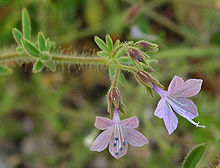
Ceanothus is a genus of about 50–60 species of nitrogen-fixing shrubs and small trees in the buckthorn family (Rhamnaceae). Common names for members of this genus are buckbrush, California lilac, soap bush, or just ceanothus. "Ceanothus" comes from Ancient Greek: κεάνωθος (keanōthos), which was applied by Theophrastus to an Old World plant believed to be Cirsium arvense.

Helianthus is a genus comprising about 70 species of annual and perennial flowering plants in the daisy family Asteraceae commonly known as sunflowers. Except for three South American species, the species of Helianthus are native to North America and Central America. The best-known species is the common sunflower. This and other species, notably Jerusalem artichoke, are cultivated in temperate regions and some tropical regions, as food crops for humans, cattle, and poultry, and as ornamental plants. The species H. annuus typically grows during the summer and into early fall, with the peak growth season being mid-summer.

Monarda is a genus of flowering plants in the mint family, Lamiaceae. The genus is endemic to North America. Common names include bergamot, bee balm, horsemint, and oswego tea, the first being inspired by the fragrance of the leaves, which is reminiscent of bergamot orange. The genus was named for the Spanish botanist Nicolás Monardes, who wrote a book in 1574 describing plants of the New World.
A gilliflower or gillyflower is:

The Heliantheae are the third-largest tribe in the sunflower family (Asteraceae). With some 190 genera and nearly 2500 recognized species, only the tribes Senecioneae and Astereae are larger. The name is derived from the genus Helianthus, which is Greek for sun flower. Most genera and species are found in North America and South America. A few genera are pantropical.

The Polemoniaceae are a family of flowering plants consisting of about 27 genera with 270–400 species of annuals and perennials native to the Northern Hemisphere and South America, with the center of diversity in western North America.

Linanthus is a genus of annual and perennial plants in the phlox family Polemoniaceae. The species are found in western North America and in Chile, with the greatest diversity in California.

Olearia, most commonly known as daisy-bush, is a genus of flowering plants belonging to the family Asteraceae, the largest of the flowering plant families in the world. Olearia are found in Australia, New Guinea and New Zealand. The genus includes herbaceous plants, shrubs and small trees. The latter are unusual among the Asteraceae and are called tree daisies in New Zealand. All bear the familiar daisy-like composite flowerheads in white, pink, mauve or purple.
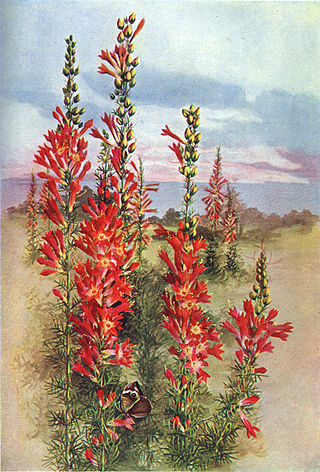
Ipomopsis is a genus of flowering plants in the phlox family, Polemoniaceae. The annual and perennial herbs it contains are native to the Americas, particularly North America.
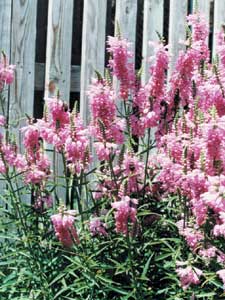
Physostegia, the lionshearts or false dragonheads, is a genus of flowering plants in the family Lamiaceae, native to North America. They are erect rhizomatous herbaceous perennials inhabiting damp, sunny places. They grow up to 2 m (7 ft) tall with purple or pink tubular flowers in racemes in summer.

Gilia is a genus of flowering plants in the Polemoniaceae family and is related to phlox. It includes 39 species native to the Americas, ranging from British Columbia to Texas and northern Mexico, and to Ohio, in North America, and from Ecuador and Peru to southern Chile and Argentina in South America. These Western native plants are best sown in sunny, well-draining soil in the temperate and tropical regions of the Americas, where they occur mainly in desert or semi-desert habitats

Astereae is a tribe of plants in the family Asteraceae that includes annuals, biennials, perennials, subshrubs, shrubs, and trees. They are found primarily in temperate regions of the world. Plants within the tribe are present nearly worldwide divided into over 250 genera and more than 3,100 species, making it the second-largest tribe in the family behind Senecioneae.

Hardenbergia is a genus of three species of flowering plants in the pea family, Fabaceae and is endemic to Australia. Plants in this genus are climbing or trailing herbs or subshrubs with pinnate leaves with one, three or five leaflets and groups of violet, white or pinkish flowers in pairs or small clusters in leaf axils. Species of Hardenbergia occur in all Australian states and in the Australian Capital Territory.

Hedeoma is a genus of flowering plants in the mint family, Lamiaceae. It is native to North and South America. They are commonly known as false pennyroyals.

Eremophila mitchellii, known commonly as false sandalwood and several other names, is a flowering plant in the figwort family, Scrophulariaceae and is endemic to Australia. It is a glabrous large shrub or small tree with flaky bark, white or cream-coloured flowers and is capable of root suckering. It is widespread and common in New South Wales and Queensland where it is sometimes a serious pest of grazing land, however essential oils from the plant have been shown to have valuable properties and have been commercially exploited.
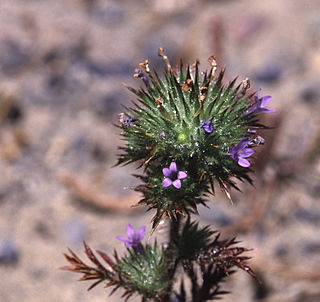
Navarretia is a genus of flowering plants related to the phloxes and the gilias. This is one genus of plants, among others, which are sometimes called pincushion plants. It includes 45 species native to the Americas. In North America they range from western Canada through the western and west-central United States to northwestern Mexico, and to Ohio and Pennsylvania. In South America they range through Argentina and Chile.
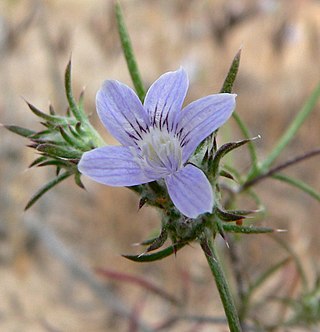
Eriastrum is a genus of flowering plants in the phlox family which are known commonly as woollystars. These wildflowers are somewhat diverse in appearance but are usually erect, thin-stemmed herbs which bear purple to white blooms. Most species have inflorescences which are webbed with a woolly mesh of white fibers. Woollystars are native to western North America.

Heterotheca sessiliflora is a species of flowering plant in the family Asteraceae known by the common name sessileflower false goldenaster. It is native to California, Sonora, and Baja California.

Triantha is a small genus of flowering plants in the family Tofieldiaceae, first described as a genus in 1879. False asphodel is a common name for plants in this genus.
